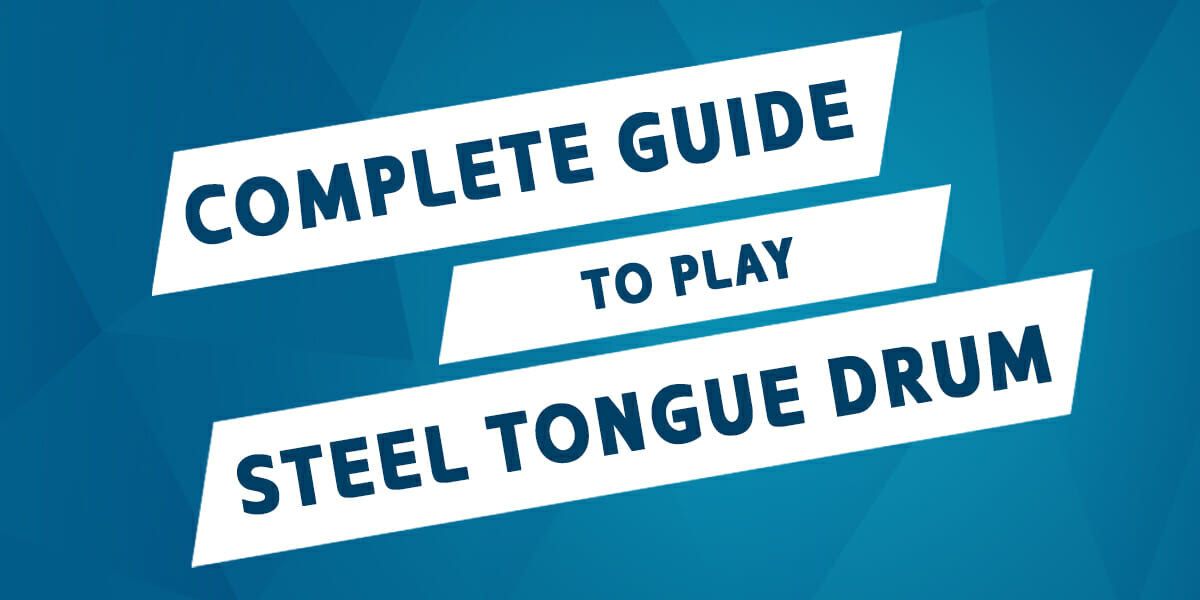
The music industry has recently given birth to a brand-new instrument – the steel tongue drum – an instrument looking more like a spaceship with a lush and tender voice.
So how to play the steel tongue drum?
Here’s a complete guide (read and get ready to play it instantly!)
Table of Contents
- Producing The Sound
- How To Play The Tongue Drum?
- How Hard Should I Tap?
- Tips To Improve Your Playing
Producing The Sound
Since its birth, the tongue drums quickly got on a high trend and provoked an explosive appearance of tongue drum crafters and makers. Now there is no shortage of tongue drums of different shapes and colors.
However, the idea is usually the same. The tongue drum has a central tongue called Ding – the lowest note, the resting tongues are placed around in the ascending zigzag order.
The tongue drums have different sizes, shape, and of course, the sound. The smaller the drum is, the more limited musical characteristics it has. An average tongue drum is usually no bigger than a football ball.
If you appreciate good sound, opt for a drum with a bigger resonating chamber like the RAV Vast tongue drum. Its size is comparable to the size of the handpan (the diameter of the RAV Vast is 20” (51 cm) compared to the average size of the handpan 22.8” (58 cm). This makes the RAV Vast produce a strong and sonorous sound.
Unlike the other tongue drums, the RAV Vast is not empty inside but has a complicated inner architecture that provides an incredibly long resonance (up to 25 seconds compared to 5-7 of an average tongue drum).
It’s a harmoniously pre-tuned drum that provides 5-7 harmonious overtones (if you don’t know what it means exactly, just remember that more harmonious overtones make the sound lush and rich).
Unlike piano or guitar, the tongue drums have a limited number of notes. All the drums have a certain note layout which is determined by the drum’s scale. So at your side, you need to choose what combination of note i.e. scale you like (and sometimes, it’s really hard to choose, they all sound so great!).
How To Play The Tongue Drum?
The idea is pretty the same for all the tongue drums. Just like any musical instrument, the melody is created by combining the strokes of different notes. Tap the steel tongues in a different order to create a melody.
Producing the sound with the steel tongue drums differs from playing a usual drum as a usual drum can produce one or two notes only and has a very short resonance. The tongue drum has a longer resonance and has from 5 to 11 notes. In general, playing the tongue drum reminds more of playing glockenspiel (if you recall your music classes at school).
Playing technique is pretty the same for all the drums, just the beginning position slightly differs for the RAV Vast. Place the RAV drum in front of you. You’ll see that the tongues have different sizes. Place the drum so that the biggest tongues are directed towards you (you should be able to read the word “Vast” curved on the top tongue). This way you’ll have the lower tongues on the bottom, while the highest notes will be on the top. Start playing by tapping the notes from the central one, moving to the bottom note, and then move upwards in zigzag order.
How Hard Should I Tap?
It differs from drum to drum, but if you have bought a high-quality tongue drum, a slight touch will be enough. Just be sure you move your fingers away quickly so the sound doesn’t get muffled.
Playing the tongue drum is very easy, even a child can make a good job of it. You can experiment by varying the striking force to get different volume and sound effects.
The tongue drums are very durable, so don’t be afraid to give it a harder stroke – you’ll get a richer and more powerful sound with a greater number of harmonious overtones (if the tongue drum is harmoniously pre-tuned, of course).
Tips To Improve Your Playing
Relax, let yourself make mistakes. Don’t try to make it perfect instantly. Save your time to get acquainted with the instrument
Tap the notes chaotically first to remember the sound of each note and then move to structure the progression
Visualize the played note pattern graphically (ex.: square, rectangle, triangle, zigzag)
Involve your voice. Speak out loud the rhythm, sing along with playing the RAV (you can involve typical drumming refrains like ta-ka-ti, ta-ka-ta, etc.)
Use the same rhythm but vary the tempo (fast-slow-fast)
Emphasize the accents (simply strike some notes a little harder than others). It will make even a simple rhythm sound more intriguing
Enrich your melody by making the ghost notes – tap the very edge of the tongue or the drum’s shoulders. The muffled sound will make a great contrast with the sonorous sound of tongues.
A pro tip for committed enthusiasts – think of composing melodies as of having a dialog. Higher speech refers to a question, and lower speech – to answer. Mix questions with the answers, experiment and enjoy the process of creating your first tongue drum composition!

